The Megalithic
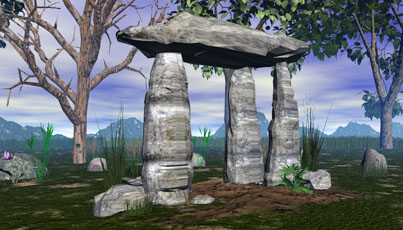
Stone. Metal. Culture.
Megalithic
Culture One
"For
all the world it feels as though both Megalithic Man and the Sumerians
shared the same teacher. The sudden development of brilliant cultures
after more than 5,000 generations of humanity and the absence of any
audit trail strongly suggests the intervention of a third party that is
no longer known."
"Unfortunately
there are no documentary records of Neolithic traditions - but we know
that the Sumerians and Ancient Egyptians specifically stated that a
group of people with, what appeared to them to be, god-like powers
arrived from somewhere unknown to instruct them in the sciences and
teach them skills in manufacturing. These
‘Watchers’ were
thought of as gods, but it is said that they looked like normal people
and they lived and died just like everyone else. While it is
fashionable today to dismiss old myth and legend as little more than
fairy stories, we believe that this explanation holds more water than
any other. Is this solution so preposterous that we have to overlook
the obvious? Stepping back from the arrogance of the belief that our
current civilization simply has to be the pinnacle of all human
achievement leaves us wondering, ‘Why on Earth do we have to
accuse our forebears of writing down nonsense?’ The first
response of any archaeologist to this thesis will be, ‘So
where
is the archaeological evidence to support the notion of such a group of
advanced people?’ This is an entirely fair and reasonable
question but our answer lies in information that we have brought
forward from our forensic examination of measurement systems. The
evidence outlined in this book appears to have demolished the standard
idea that there was a slow, incremental improvement of
humankind’s understanding of science and nature from Stone
Age to
Internet Age. Like Charles Dickens’ Mr. Gradgrind, we love
facts,
and we set out to find more facts than had previously been available.
The whole idea of a ‘Civilization One’ is not going
to
appeal to many academics - and we fully understand why. This kind of
notion has to be treated with great caution. Yet it does explain how
these fantastically sophisticated units existed in cultures that were
otherwise rather unsophisticated. Could it be that there was once a
single, highly-advanced group that virtually kick-started the
world’s first civilizations? If so, it appears that it failed
in
the case of the Megalithic culture because it seems to have died
out...Others may identify a different solution, but in our estimation
it would be impossible to create this interrelated Megalithic/
Mesopotamian measurement matrix from a cold start. In other words, the
Earth, Moon and Sun as well as the speed of light and the orbiting
Earth would have to be measured using some arbitrary units before it
would be possible to create units that produced such wonderful integer
results. If we are correct regarding this point, the inference has to
be that Civilization One was as advanced as the modern world, though
far, far back in time during the period we refer to as prehistoric."
(http://sociologyesoscience.com/cult_archeology/cultarch.html)
"In 2004,
Alan Butler went to work with Christopher Knight, and together they
authored an excellent book on the significance of the Megalithic Yard.
In this book, entitled Civilization One: The World Is Not As You
Thought It Was, Butler and Knight successfully demolish the long
accepted fallacies concerning the primitivism of ancient man. They
write:
Generations of investigators have
assumed that stone
circles and other prehistoric monuments were built for some unknown
pagan ritualistic purposes by otherwise unsophisticated Stone Age
tribes...The evidence of Thom's Megalithic Yard has demolished any
notion of the naivety of its creators assumed by most archaeologists.
We have to respect these forgotten people for the great astronomers and
geometricians they certainly were.
It seems that there must have been a
Civilization
One; an advanced people who trained the rest of the world in science
and technology, thereby leading it out of the Stone Age."
(http://www.irishoriginsofcivilization.com/appendices/recentdiscoveries.html)
Egypt's
Elder Culture
"There
is
compelling evidence to suggest that the Ancient Egyptians inherited
their great wisdom from a much earlier Elder culture which was able to
pass on the flame of knowledge before its own apparent demise. As we
see, all the indications are that the Elder gods inhabited Egypt some
between c . 12,500 and 9500 BC . They build the Sphinx and the earliest
megalithic temples of Giza, and they achieved a high level of
sophistication later encapsulated in the design of the Great Pyramid ...
"
(http://alvidk.tripod.com/id35.html)
The
term "Elder Culture" seems to be a term created by Andrew Collins. This
term may relate to "elder gods" of the Titan/Olympian gods of the
Greeks.
"Egypt
has recorded and kept eternally the wisdom of the old times. ...all
coming from time immemorial when gods governed the earth in the dawn of
civilization." - Plato
Egypt is known as the Land of the Pharaohs. Perhaps it should be known as the Land of the Neters. The roots of Egypt's grand civilization starts with the Neters the "civilizer Gods". Since you have gotten this far it should come as no surprise that the terms civilizer gods rings a bell. Neter means "guardian" or "Watcher". As these early Egyptians tell it themselves these Neters journeyed from the "land of Ur" and that they came from the south by boat. These gods were both superhuman and mortal. What we see here is the spread of civilization to the world from a tradition rooted in Mesopotamia. You will find it in India and you will find it in Mesoamerica. When the tools of civilization arrive so do the legends of anthropomorphic gods who are divine yet mortal. Authoritatively intellectual, undeniable in their leadership capabilities, always recognized as the carriers of an ancient high culture these inventive and far roaming Andites spread civilization to the world at large.
"But before we deal with that city situated on the plains of Shinar (SHU.MER/Sumer/Sumeria ) we must give some background on the pre dynastic, even pre historic "history" of Kemet. As the Egyptian mythologies tell us, the Black Land was, in it's early stages, a land of low civilization where religion/science was not known and even the practice of cannibalism was prevalent. That is until the civilizers... those worshiped as Gods by later generations of Egyptians came from the far off "olden land". The "civilizer Gods" were called Neters ( NTR ) which according to comparisons with other Semetic languages means "Guardian" or "Watcher". These Neters had supposedly arrived in Kemet by boat from the Red Sea ( there is also evidence to suggest that these same Neters had been present in the Horn of Africa and West Africa at earlier dates than their arrival in Egypt ) or Sea of UR which they had entered via Ta Neter ( Ta Neter meant "Place/Land of the Neters/Gods" ) which is the narrow straights at the southern end of the Red Sea now called Bab'el'Mandeb. These Neters journey had originated in Ta UR ( Ta UR meant "the olden land" or more simply "Place/Land of Ur" ) which could be reached by exiting the Red Sea and following the coast towards the left. This type of course would have led a traveler towards the Persian gulf, towards Mesopotamia and Sumer!
So
according to their own
admission, the "civilizer Gods" of the Egyptians, called Neters or
"Guardians/Watchers" had originated in a place called "the land of Ur"
which could be located somewhere in the area of the ancient Middle East
called Sumer. The place name Ur is of course known as the starting
point of the travels of the Hebrew Isra'Elite patriarch Abraham."
(http://groups.msn.com/StarChildren/yourwebpage1.msnw)
"...during
the mythical age of the gods, the Zep
Tepi, or First Time. As has been ably demonstrated by recent works from
Hancock, Bauval et al, this believed mythical age, when gods ruled the
earth, appears to have been an actual stage of human development
pre-dating Pharaonic Egypt by many thousands of years."
(http://www.newdawnmagazine.com/articles/Baalbek%20-%20Lebanons%20Sacred%20Fortress2.html)
The
term NETER hieroglyphically is written as N35  X1
X1  D21
D21  or R8, A40
or R8, A40
 ,
where sign N35 is "N", sign X1 is "T", and sign D21
is "R",
and additionally, the signs R8 and A40 also stand for NETER,
that
is TANRI in Turkish. Thus, It has the shortened form of "NTR" which has
been transliterated as NETER. The "E"vowels are filled in either by
Wallis Budge himself or together with other Egyptologists. In other
words, the hieroglyphic writing could just as easily have been
transliterated as "NATAR". When NETER or NATAR is viewed as
"N-ETE-R" or "N-ATA-R", we find that it is a composite word
made
up from three Turkish words. They are namely the Turkish words AN
meaning "SKY", ATA meaning "FATHER", and ER meaning "MAN".
Thus,
viewed in this manner, NETER would mean"Sky Father Man".
(http://www.polatkaya.net/NETER.html)
,
where sign N35 is "N", sign X1 is "T", and sign D21
is "R",
and additionally, the signs R8 and A40 also stand for NETER,
that
is TANRI in Turkish. Thus, It has the shortened form of "NTR" which has
been transliterated as NETER. The "E"vowels are filled in either by
Wallis Budge himself or together with other Egyptologists. In other
words, the hieroglyphic writing could just as easily have been
transliterated as "NATAR". When NETER or NATAR is viewed as
"N-ETE-R" or "N-ATA-R", we find that it is a composite word
made
up from three Turkish words. They are namely the Turkish words AN
meaning "SKY", ATA meaning "FATHER", and ER meaning "MAN".
Thus,
viewed in this manner, NETER would mean"Sky Father Man".
(http://www.polatkaya.net/NETER.html)
The
symbol  is
a determinative which means the name following it is divine which is
exactly how the Sumerians used the
is
a determinative which means the name following it is divine which is
exactly how the Sumerians used the  asterisk
or star sign and is called a dingir. An in Sumerian also means "Sky Father".
asterisk
or star sign and is called a dingir. An in Sumerian also means "Sky Father".
The
Evidence of Archaeology
"...Yet the date is set somewhere
about 5000 BC, or some 7000 years ago, a tiny segment of the total of
500,000 years. What was happening during this immense period of
stagnation? And what happened that suddenly in a period of only 2000 or
3000 years at the most, a circle of astonishingly high civilizations
suddenly sprang into being in Sumer, Egypt, and in the Indus Valley?
The sudden appearance of these ancient civilizations was as evident as
it was unexpected. The time lapse in each cultural center from initial
settlement to established civilization was completed within a few
hundred years...
Neither in Egypt or in Babylonia has any beginning of civilization been found. As far back as archaeology can carry us, man is already civilized, building cities and temples, carving hard stone into artistic form, and even employing a system of pictorial record...The fact is very remarkable in view of modern theories of development and of the evolution of civilization out of barbarism...In any case, the culture and civilization of Egypt and Babylonia appear to spring into existence already fully developed. Archaeology at all events has failed to discover the elements out of which they ought to have grown...
Pottery Halaf
Some sites in Syria bear witness to this same
peculiar aspect of Middle East cultures. T. J. Meek in this connection
wrote: (55)
Tell Halaf has revealed the most wonderful handmade pottery ever found.
Although the lowest strata here are probably representatives of the
oldest culture so far definitely attested [this was in 1938], yet it is
already clearly chalcolithic. From various indications we know that
metal was used, although not very extensively. In this period great
skill was shown in the working of obsidian into knives and
scrapers...The pottery of Tell Halaf was made by hand, unbelievably
thin, indeed not thicker than two playing cards, and shows an
extraordinary grasp of shape and decorative effect in color and design.
The pottery was fired at great heat in closed kilns that permitted
indirect firing with controlled temperatures. The result of the intense
heat was the fusion and vitrification of the silicates in the paint so
that it became a genuine glaze that gives the surface a porcelain
finish quite different from the gloss of burnished ware so common later.
Technically and artistically the Tell Halaf pottery is
the finest
handmade pottery of antiquity and bears witness to the high culture of
its makers.
Where are the long ages of development? An early contemporary culture
in Mesopotamia was being evolved at Al Ubaid. It represents one of the
root settlements of the later Sumerian civilization. V. G. Childe wrote
of these people: (56)
The authors of the Al Ubaid culture cannot have sprung from the marsh
bottom, and the culture itself shows no sign of having developed
locally from any more primitive Mesolithic forerunner...
This then seems to be the picture. Somewhere in this Iranian highland a small group of people settled who needed little time to develop sufficiently to create the later culture complex which characterized first of all Jarmo and then Sialk. From here, or from some similar site in about the same stages of development, emigrants set out towards the West to settle finally at Tell Halaf. Others went south, dividing into two bands, the one passing around the lower end of the Zagros Mountains where they came up into the plains of Mesopotamia from the south, and the other turning to the east and finally establishing themselves in the Indus Valley. From Mesopotamia and Northern Syria it seems, more adventurous spirits traveled on until they reached Lower and Upper Egypt. And all this took place within a remarkably short time...
It is important to observe the sequence of events. First, for perhaps a quarter of a million years, intelligent men, to all intents and purposes apparently much like ourselves, advanced their culture scarcely at all. Then appeared a settlement in the Iranian Highlands near the traditional site of the landing of the Ark, which within a period of perhaps 1500 years evolved into a culture in the Mesopotamian plains which in turn, within a thousand years, developed into a series of high cultures scarcely paralleled until comparatively modern times. And finally, after this sudden burst of activity lasting possibly a further 1000 years, which witnessed some of the greatest cultural achievements in Babylonia, Egypt, and the Indus Valley which the world has known, the process once more slowed up until many prosperous centers decayed and disappeared, and much of India, Africa, and Europe remained in a state of semi-barbarism till well on towards Roman times, and in some instances much later.
The
sequence is, then, an unbelievably long time
with almost no growth; a sudden spurt leading within a very few
centuries to remarkably high culture; a gradual slowing up, and decay;
followed only much later by recovery of lost arts and by development of
new ones, finally creating our modern world."
(http://custance.org/old/incarnation/ch3.html) This link is no longer
available so it is not possible to follow up further on the
questionable "traditional
site of the landing of the Ark"
in Iran which would be Mount Suleiman in the Elburz Mountains if this
is based on Robert Cornuke's published claims.
Pottery Susa
"It
is chiefly by the many thousand broken pieces of pottery
found in the lowest deposits of the Susa mound that the story has been
built up, bit by bit, of these unknown immigrants from an unknown land;
something like the reconstruction of the unseen, lame, half-blind camel
in "The Arabian Nights." This pottery is wonderfully hard and thin, not
much thicker than a couple of postcards, and it rings like porcelain,
though it is not so transparent. The forms are simple and graceful;
they were produced on a rudimentary potter's wheel, used with a skill
that was probably due to the inherited experience of many generations
of craftsmen. Nearly all the bowls and vases were elaborately decorated
either inside or outside with strange designs, most of which have no
similarity with any designs found in other parts of the world, so that
we have no due to the country where these potters learned their art,
though we can be fairly sure that they brought it from some centre of
civilization where it had been undergoing a long period of development.
For it is now admitted that ornamental designs in all countries and in
all ages are not the chance product of the craftsman's brain-they have
a regular evolution from the simple to the complex, most of the simple
designs being evidently based on natural forms of men or animals."
(http://mcadams.posc.mu.edu/txt/ah/Persia/Susa.html)
The Megalithic occurs somewhat in parallel with the Neolithic, the New Stone Age, and spans into the age of metals. At Çayönü the use of copper has been found and dated to somewhere around 7,000 B.C. If we accept the date of 9,000 - 10,000 B.C. for Göbekli Tepe then the start of the Megalithic has its first evidence just before the time of the Neolithic. The term Megalithic means very large stones (used in structures). Just previous to the Neolithic is the Mesolithic Age when hunting and gathering were all the rage. It was the Neolithic when things really started to happen and it very roughly dates between10,000 and 2,000 B.C. overlapping the ages of metal. The end of the Neolithic is open ended due to the varying technological advances of differing locations. All dates relating to these differing ages are relative as they do not appear within a smooth continuum. Rather they come into being at differtent times in different places so using "about" is appropriate. Thus there are many differing opinions about these dates. The starting date for the Neolithic on this website is based upon the beginning of farming in the Zagros. Also all dates regarding the beginnings of civilization are being pushed back farther into the past.
The engineers of the megalithic monuments were the Andites and their descendants. They were big thinkers as evidenced by what they built. Not only were these constructions impressively large but many contain methods and meanings not which all is understood. When looking at the scope of these projects like Baalbek, Stonehenge and the pyramids one is drawn to the conclusion that whoever oversaw these constructions were well informed civil engineers skilled in mathmatics, geometry and astronomy. These people who carried megalithic building skills were seemingly professionals schooled in many disciplines. Concerning astronomy if you were really really smart you would be aware of the precession of the equinoxes and they were. Yes, cave men sitting around the fire discussing the problem of sighting the point in empty space upon which the wobble of the earth's rotation revolves around. I love this stuff. To understand astronomy requires a long time of observation over the lifetimes of many generations. Then you would have to accumulate these observations and continue to pass on this collective knowledge over an enormous length of time. As to passing on of this knowledge one theory has it that the structures encoded the math and geometry as a pneumonic device that would last long after the original builders were gone. This knowledge of say knowing the earth was a sphere and that latitude affected observation would help you navigate vast distances over land or water and discover America in 2200 BC.
This sophisticated knowledge always passed through the ancient elite. They were the carriers of culture. They became priest kings. But the crux of the argument is this: to explain how geometry and astronomy combined with mathematics was laid down by a Paleolithic culture which used such knowledge to build these awesome structures with no previous evidence or source from which such knowledge was drawn. The megalithic culture (first world civilization) was a world wide phenomenon.
Five
Examples of What They Built
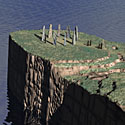 Stone
Circles
Stone
Circles
There are numerous stone circles (about
900 - 1000)
found throughout the British Isles. The
most famous stone circle is of course Stonehenge. This megalithic
monument on the Salisbury Plain is perhaps the most studied stone
circle of all. The earliest date for its construction
is about
3100 BC with 2300 BC for the start of erecting the stones. Some
stone circles like Stonehenge besides being open air temples were
astronomical observatories marking both solar and lunar phenomenon
(Castlerigg is another one). Not all circles do this. Many
sites have an orientation to some type of celestial phenomenon such
as soltices, helical rising stars, constellations and such. Others have seemingly only a mortuary
purpose. There are so many in some places that they are referred to as
a
field of tombs. The Carrowmore Megalithic Cemetery has more than 60
megalithic tombs forming a ritualistic landscape and it is Ireland's largest dating from
about
3,000 BC. It contains dolmens, passage tombs and circles refered to as
stone kerbs. It is not unusual to find a tomb within a circle. The
earliest stone circle, if we can call it that, is located at Göbekli
Tepe and dates to about 9,000 BC. Three of these ceremonial circles
have been unearthed so far
and contain T shaped monoliths weighing on average 10 to 20 tons. These
monoliths are carved with animals and abstract designs which is a
sophisticated achievement for these pre-neolithic hunters and gathers.
The
largest circle is located in Avebury England and spans within the henge
about 1300 feet. A
henge is an earthen bank with the usual accompaning ditch. Some
sites are henges only such as the Thornborough Henge complex.
 Dolmens
Dolmens
Dolmens in Britain are called Quoits, in Portugal they
are called
Antas. They are megalithic mortuary stone chambers. Although
they come in a variety of styles the classic construction is of three
or four vertical slabs supporting a large capstone. Some are more
walled in but the vertical stones and large capstone is the hallmark of
the dolmen. A great number
of these dolmens have vertical supports that are pointed giving the
impression of having
the roof lightly resting on them. Even when a flat surface was
available the stone support was often rotated to a corner up position. Some
of the capstones are over 40 tons. The
Urantia Book says the Andites built "stone
huts" in
which the dead were cremated. Originally, say archeaologists, these
stone structures were covered with dirt thus forming a mound. Related
to Dolmens are the megalithic cairns which are also called passage
tombs or graves. A good example of these structures can be found in
Loughcrew Ireland, with the most famous cairn being Newgrange which
was most likely built around 3200 BC. Like Newgrange these cairns have
clear astrological
alignments. The Loughcrew cairns may represent the oldest cemetery in
the world. And related to the cairns are the tumuli (plural
for
tumulus, or small mound). These look like cairns as they are completely
cover by stones. A large field of these dolmen/tumuli is located in the
Golan heights. But dolmens are found from western Europe to China and
India. Denmark also has many as well.
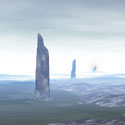 Standing
Stones
Standing
Stones
Also
called menhirs these standing
stones
usually
are erected as a single stone. These simple stones may in fact be the
most complex of megalithic monuments when trying to understand their
reason for being. They are used for circles which can be very
impressive looking, used in rows both single and double with or without
circles, used in constructing dolmens and found to be used as a line of
sight for alignments. Some think they are boundry markers and even as
representing locations on earth by referencing the pattern of stars
within constellations. You could call them Neolithic star maps. Another
way of explaining this placement of stones is a land
survey by astronomy. These stones have been found in Turkmenistan and
were elaborately carved during the Iron Age. They could be the
inspiration or out growth for the stele of the Assyrians, Babylonians,
Egyptians and Mayans. To enlarge on this idea they could be the
forerunners to
the Egyptian obelisk. And depending on how you wish to interpret the
meaning of these ancient stones they may be represented in the
colonnade surrounding the first Egyptian temples. This concept of the
colonnade was later used extensively in Greek and Roman architecture.
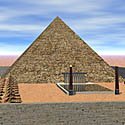 Pyramids
Pyramids
The
first pyramid built in Egypt was at
Saqqara at about 2,600 BC. This pyramid was designed by Imhotep.
The largest is Khufu the Great Pyramid and also the oldest in the group
of three. Date for Khufu's pyramid is about 2,500 BC. The math
associated
with Khufu is as amazing as the pyramid's precision. This pyramid also
contains the golden ratio. Average weight of the blocks is 2.5 tons.
Pyramid building was a world wide phenomenon. China has many pyramids a
number of which are impressive. The legendary White Pyramid has been
reported to be almost 980 feet hight and about 1,640 feet wide at the
base. “The
pyramid is about 1,000 feet high (other descriptions estimate 1,000 to
1,200 feet high) and roughly 1,500 feet at the base, which makes it
twice as large as any pyramid in Egypt. The four faces of the structure
are oriented with the compass points” (Shroeder in 1912, http://www.world-pyramids.com/china3.html).
There are other massive pyramids elsewhere in the world. The so-called
Bosnian Pyramid of the Sun in the town of Viscko is one. Its height is
estimated at 720 feet. Other European pyramids are located near Milan
Italy. These are the pyramids of Montevecchia discovered in 2003. There
are 16 known pyramids in Greece. Many countries have pyramidal shaped
mountains that could contain a pyramid. Locations include Croatia, the
Koreas, Romania, Russia, Serbia, Sicily, Spain, Turkey and the Ukraine.
In the New World we have more famous pyramids. The Incas of Peru built
a number of them. At Tucume 26 have been unearthed. The most famous
Mayan pyramid is El Castillo at Chichén
Itzá. Other
major Mayan pyramid cities include Copan, Tikal and Uxmal. The Aztecs
built pyramids as well. Just north of Mexico City is Teotihuacan with
its Avenue of the Dead and three pyramids.
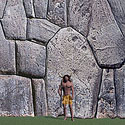 Foundations
and Walls
Foundations
and Walls
The
most notable of megalithic walls are the stone
walls at Sacsahuaman and the lower foundation is built in the polygonal
style of
construction. It was these walls that the later appearing Incas built
upon. However, many web sites consider all Peruvian and Bolivian
polygonal construction as Incan. But a wall of polygonal blocks exists
on Easter Island (one of the last) and is considered as from a pre-Inca
civilization. "Perhaps
the upper part of the walls, constructed of small, regularly-shaped
stones was the only part of Sacsahuaman that was built by the Incas and
"finished in 1508." This could explain why no one at the time of the
conquest seemed to know how those mighty walls were built." (©
2003-2004 by Richard
Nisbet http://www.world-mysteries.com/gw_rnincas.htm)
"The
possibility
also exists
that the Inca’s were latecomers to the area taking over
pre-existing building sites and adding to them. This theory
is
given some credence by the fact of the obvious differences in the
quality and style of architecture, where later generations of Inca
added to and in some cases expanded existing structures.
Many
of the sites
further a field in Mesoamerica fit the same pattern, many show two
distinct and different architectural styles and levels of technology,
this is true for the Mayans and the Aztecs and not just the Inca."
(http://personalpages.tds.net/~theseeker/Viracocha.htm)
Lixus Morocco also has megalithic foundations resembling those in Peru. The Romans built upon these the same way the Incas did in Bolivia. Machu Pichu also has in some locations polygonal construction. This polygonal style is also found in several places in Greece. A retaining wall at the Temple of Apollo at Delphi and locations about the Acropolis have examples of this style of building. There are other sites with what is called cyclopean constructure named after the folk legend of Cyclops. These large blocks are the usual rectanglular shape and although megalithic in size they are not as interesting or unique as those of the polygonal style. There cannot be a complete discussion on megalithic construction without mentioning the great terrace at Baalbek. There are three famous blocks laid end to end at the top of the back wall that are called the Trilithon. They are estimated to weigh in at 1,100 tons each. They were quarried about a quarter mile away, transported up hill and lain in place with the usual exacting precision so common with Andite megalithic construction. No mortar was used. These are the largest stone blocks used in construction in the world. There are also polygonal stones in use at Baalbek. There is a stone block not fully quarried at Baalbek named Hajar el Hibla. It weighs an estimated 1,200 tons. This is the largest block of stone in the world. Additional places for polygonal construction are Turkey and Egypt.
 All
of this is very impressive until we look at the most recent
discoveries. At Baalbek a new and even larger stone block has been
located next to the Hajar el Hibla. It is now being excavated. But
there are even larger blocks of stone out there. At Gornaya Shoria,
Russia, are blocks within a wall estimated to be between 3,000 and
4,000 tons. That would mean that these blocks are three to four times larger than those at Baalbek. This
site was first explored in 2013 and has yet to be scientifically
investigated. There is a second location of
another megalithic wall at Gora Livadiyskay, Russia. The common name is Pidan and the wall which is
straight runs about 350 to 400 meters (.20 to .25 miles). It is located
on Mount Pidan and at the start of the wall is a dolmen. There is not
much information on this wall. This location is at the top of a ring of
Megalithic sites that travel down through the Koreas and back up
through Japan. As you can see it is an impressive grouping of Megalithic sites. Click on map for details.
All
of this is very impressive until we look at the most recent
discoveries. At Baalbek a new and even larger stone block has been
located next to the Hajar el Hibla. It is now being excavated. But
there are even larger blocks of stone out there. At Gornaya Shoria,
Russia, are blocks within a wall estimated to be between 3,000 and
4,000 tons. That would mean that these blocks are three to four times larger than those at Baalbek. This
site was first explored in 2013 and has yet to be scientifically
investigated. There is a second location of
another megalithic wall at Gora Livadiyskay, Russia. The common name is Pidan and the wall which is
straight runs about 350 to 400 meters (.20 to .25 miles). It is located
on Mount Pidan and at the start of the wall is a dolmen. There is not
much information on this wall. This location is at the top of a ring of
Megalithic sites that travel down through the Koreas and back up
through Japan. As you can see it is an impressive grouping of Megalithic sites. Click on map for details.
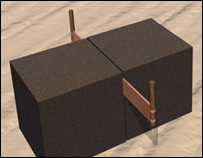
 Copper
Slab Saws
Copper
Slab SawsThe Egyptians used the copper slab saw, a toothless band of copper, that used an abrasive to cut through the stone. There is undisputed evidence that slab saws were used to cut stone blocks in Egypt. Note how the slab saw to the left could be used to clean up the adjoining faces insuring a very tight fit when pushed together. The Egyptians also used circular saws. However the question as to who used the saws first still remains unanswered. No one knows how old Baalbek is where there is evidence that saws were used to cut stone. The marks are from a circular saw. Friedrich Ragette suggests that a circular saw with a radius of 4 meters was used in the quarrying of Baalbek's largest blocks. This would mean the saw blade would be about 26 and a quarter feet in diameter.
(Ragette, Baalbek, p. 115 1980 from: http://www.bibliotecapleyades.net/arqueologia/esp_baalbek_4.htm)
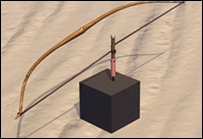
 Copper Boring
Tools
Copper Boring
ToolsAs with slab saws there is unquestionable proof that the ancient Egyptians used copper boring tubes also called bow drills. These copper tools have been shown to work but the stone ate the copper at a fast ratio of approximately 3:1. That is one inch of cutting used three inches of copper. The Egyptian illustration is from inside the Saqqara pyramid. So at the time of the building of Egypt's first pyramid the bow drill was already in use. Examples of both saw and drill technologies are in the Cairo museum. Use of the copper boring tool can be also found at ancient Argob. Sketches made of the hard black basalt window shutters at Argob have cleanly bored holes through them.


Copper,
Bronze and Iron
Copper
was
the
first most widely used metal in the ancient world. The Egyptians mined
tons
and tons of it from what is considered the world's oldest copper mines.
These are the copper mines of the Timna Valley. "The
Hathor Temple of Timna provides the first archaeological evidence for
actual and lengthy Egyptian control of this area." (Timna, Beno
Rothenberg, 1969 AD) Egyptian mining dates
from 2000 BC to 1200 BC. It would hardly have
been a
secret that copper was in abundant supply at this location. And
everyone wanted it.
The
above tools are
made of copper. Experiments have used copper in this way and it works
but it does not work with all tools such as chisels. This brings up
the question whether archaeologists are right about Egyptians using
only copper tools. The traditional view is that the Egyptians used only
copper for tools and other implements. It seems odd that Egypt
would not know
about bronze in light of their familiarity with copper and their
closeness
with the Phoenicians. One
of Egypt's closest trading partners was Phoenicia. It was in Phoenicia
where bronze may have first been smelted. "Bronze Age smelting
techniques
arrived in the region [the
Cyclades] with
settlers from the East, probably Phoenicia,
about 3,000 B.C..." (http://iaphomepage.org/int108/no108pg1.html)
All dates for the
earliest smelting of bronze are estimations but
between 3,500 - 3,000 BC is the accepted timeline. The first stone
pyramid in Egypt dates to about 2600 BC. Evidence is mounting
that we must include Anatolia as the birthplace of smelting bronze as
well. Even the date for smelting iron is being pushed further into
antiquity:
"On Friday May 26th 1837, during the Vyse excavations at Giza, one of the excavators, J R Hill, found an iron plate embedded in the cement of an inner joint at the southern `Star Shaft' of the Kings Chamber. It was around 12 by 4 inches and 1/8th of an inch thick. 1 More interestingly it was deeply embedded in the masonry and had to be removed by blasting apart the outer two tiers of stones.
In
1989 a fragment was taken from the plate found by Hill, and was tested
by two eminent metallurgists Jones and Gayer who concluded that it was
very ancient. Significantly they stated that the metallurgical evidence
supported the archaeological evidence that it was incorporated within
the pyramid when it was built. More importantly they went on to
determine that the iron was not meteoritic, had been smelted at a
temperature of between 1000 and 1100 degrees centigrade, and bore
traces of gold on one of the surfaces of the plate.
What holds back the acceptance of iron in antiquity, apart from the rarity of finds, is the erroneous assumption that it must have been poured to make it useable....A temperature as low as 900° Centigrade in a charcoal furnace will easily separate iron from its ore....To smelt copper from its common ore of Malachite a temperature of between 700° and 800° is required, which would easily have been achieved by the kilns of the ancient world." (http://www.gizagrid.com/egyptian_iron.html © Keith Squires 2005)
Keith Squires goes into much more detail on the ancient smelting of metals and makes a convincing argument for dating the smelting of iron both in Anatolia and Egypt to a much earlier time. He also explains why the scarcity of metal from this very early time frame and the technology of these early furnaces to smelt copper and iron.
"The earliest iron was probably a byproduct of copper smelting, as copper ores almost always contain iron. Chalcopyrite, for example, contains about thirty percent iron. When iron ore was smelted, what would be produced would be a spongy mass of iron, slag, and cinders which has to be hammered to remove the slag and air bubbles. This was so-called wrought iron. Wrought iron was forged while still in its heated, soft, and ductile state." (http://www.asa3.org/aSA/PSCF/1993/PSCF12-93Yamauchi.html ©1993 EDWIN YAMAUCHI Department of History, Miami University, Oxford, OH 45056)
These two above authors taken together demonstarte that the chances of iron smelting by the Egyptians is wholly probable even unto the time of the building the pyramids at Giza. The Egyptian mined tons and tons of copper. Even if there was only a small amount of iron present it still would have been a considerable amount. The Egyptians did smelt copper and had furnaces that could have smelted iron. This hot iron could have been hammered into useful tools and implements. A French archaeologist named Gaston Camille Charles Maspero wrote a book called a MANUAL OF EGYPTIAN ARCHAEOLOGY and Guide to the Study of Antiquities in Egypt. It was published in 1895. In it he also argues for the use of iron tools by the Egyptians explaining that only iron could work stone as hard as diorite, basalt, and the granite of Syene. As for losing their edge the tools would be returned to the forge to be fixed. This observation was made by M. Maspero first hand of local artisans sculpting stone statues for tourists while in Egypt. (http://www.gutenberg.org/files/14400/14400-h/14400-h.htm)
Megalithic Tool Kit:
Copper and Bronze - Megalithic building spanned both the Copper 5500 BC and Bronze 2250 BC AgesWheel - discovered by the Sumerians but may have been used by the earliest Egyptians
Levers - probably one of the first simple machines discovered
Wedge - Egyptian
Copper slab saws and copper boring drills - Egyptian
Counterweights - Egyptians knew how to use them at the time they built the pyramids
Surveying Skills - self evident
Mathematics/Geometry - this has been confirmed through reversed engineering
Astronomy - same as above
Standard Units of Measure - the "megalithic yard" which is British
Square
Level
Plumb Line
Theories
on Raising the Blocks of Stone
"An
alternative method of raising the blocks is suggested by a comment the
Greek historian Herodotus made in the fifth-century BC. When Egyptian
priests were showing him the GP, they told him that the stones had been
lifted with levers made of short timbers. Some theorists feel that this
clue may offer a better solution than the ramps...
Some theorists suggest that
a simple machine using levers and counterweights was used to elevate
the blocks. Such a machine, called a shadoof, has existed in Egypt for
millennia and is still used to elevate pots full of water from the Nile
River to the irrigation canals. Though a shadoof itself could never
lift a 2.5-ton block, engineer Olaf Tellefsen (1970) observed three men
using a similar machine to lift very large stones while he was riding
up the Nile. Even so, a few considerations must be met before one can
propose a machine that could be used on the GP. First, it must fit and
be capable of operation on the pyramid's stepped face. Second, it must
be manageable and controllable so that damage would not be done to the
blocks being lifted and so that workers would face a minimal risk of
falling or being knocked off the edge. Third, it should be simple so as
to align as closely as possible with the scant archaeological record
that such machines can claim. Finally, it must be capable of lifting at
least 5000-6000 pounds."
(http://homepages.inf.ed.ac.uk/jbaldrid/papers/pyramid.htm)
Why the Megalithic Culture did not Survive
There
was a long and very slow evolutionary growth
of human knowledge that was radically up stepped by the ideas, ideals
and technology of Eden. This high culture of Eden was carried out to
the emerging world by the Andites, a pre-Sumarian stock. They make their
appearance in
the fertile crescent and not in southern Mesopotamia. It was in the
region of the fertile crescent where the Adamites and Nodites migrating
outward to this pastoral land, interbred with the original inhabitants
and started the cultural revolution that would encompass the entire
planet.
This is the megalithic
culture that some archaeologists speculate as the "hidden high culture"
found around the world. Theological concepts from Mesopotamia found in
Mesoamerica, stepped
pyramids found in China, dolmens found in Korea and the academic jury
is still out as to how all of this fits together. But eventually
numbers won out and the overwhelming genetic pool of indigenous peoples
absorbed the Andites into their ranks. When the Andites were gone so
was their culture.
"These civilizations [Indus Valley Civilization, the Sumerians, Egyptians, and Mesoamerican cultures] were formed fully intact with no known pre-cursors having fully formed sophisticated writing, mathematical and technological systems. These civilizations had advanced medical knowledge, agriculture and law. All of these civilizations claim that they got their knowledge directly from their celestial gods and goddesses. These civilizations also claim that their “Gods” actually established “Kingship” and sat the thrones of their lands from earliest history.
One accepted theory of the time strongly argues that there had to have been an as yet unnamed or undiscovered civilization whose influence must have spread independently to each of these civilizations. This theory would best explain the common features and the fundamental differences between one civilization and the next...
Another example of
diffusion is the history of
human languages. Almost all the languages of Europe, Asia and
northern India share enough common points of vocabulary, syntax and
usage that it’s obvious they stem from a single
'Proto-Indo-European Language group'."
(http://personalpages.tds.net/~theseeker/New%20Evolution%20of%20holy%20books.htm)
Conclusion
The megalithic which is a cultural definition spans from the time of
Goblecki Tepe 9,000 BC to Mesoamerica estimated at 1,000 BC but could
go later even into the AD period. No one knows for sure. One reason why
there were Edenic influences
moderately intact in Europe and perhaps elsewhere is the Andite
domestication of the horse. It was the
speed of the horse that allowed culture to spread to the west in a more
cohesive fashion. As far as migrating into India, the Andites were
first
known as the Dravidians and later as the Aryans. In fact anywhere
culture has been discovered the Andites were there first. This culture
included religion, agriculture (and therefore stone circles),
architecture, astronomy, metallurgy,
writing, and of course megalithic building skills.


